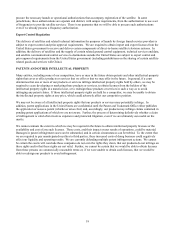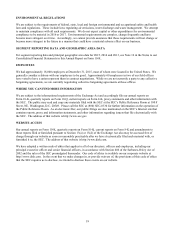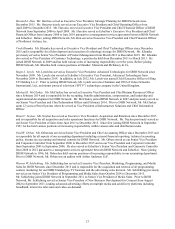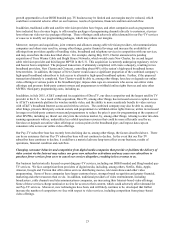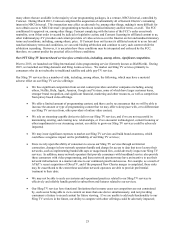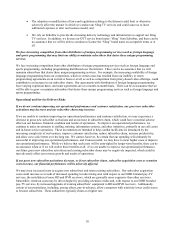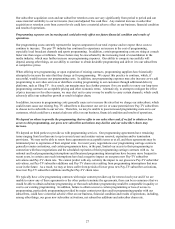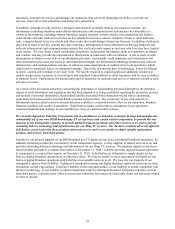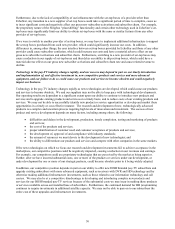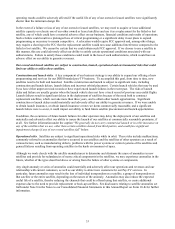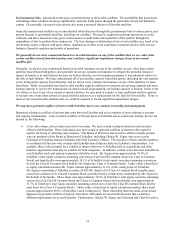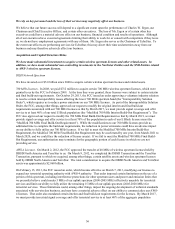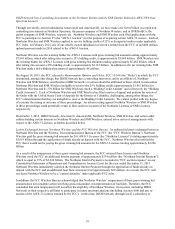Dish Network 2015 Annual Report Download - page 38
Download and view the complete annual report
Please find page 38 of the 2015 Dish Network annual report below. You can navigate through the pages in the report by either clicking on the pages listed below, or by using the keyword search tool below to find specific information within the annual report.28
We may not be able to obtain necessary retransmission consent agreements at acceptable rates, or at all, from local
network stations.
The Copyright Act generally gives satellite companies a statutory copyright license to retransmit local broadcast
channels by satellite back into the market from which they originated, subject to obtaining the retransmission consent of
local network stations that do not elect “must carry” status, as required by the Communications Act. If we fail to reach
retransmission consent agreements with such broadcasters, we cannot carry their signals. This could have an adverse
effect on our strategy to compete with cable and other satellite companies that provide local signals. While we have
been able to reach retransmission consent agreements with most of these local network stations, from time to time there
are stations with which we have not been able to reach an agreement. We cannot be sure that we will secure these
agreements or that we will secure new agreements on acceptable terms, or at all, upon the expiration of our current
retransmission consent agreements, some of which are short-term. We currently have a pending lawsuit with one major
broadcast television network alleging, among other things, that the PrimeTime Anytime™ and AutoHop™ features of
the Hopper set-top box breach its retransmission consent agreement. See Note 15 in the Notes to our Consolidated
Financial Statements in this Annual Report on Form 10-K for further information. In the event a court ultimately
determines that we breached the terms of that retransmission consent agreement, we may be subject, among other things,
to substantial damages and we may lose access to programming or may not be able to renew that retransmission consent
agreement and other programming agreements on favorable terms or at all. Even if we ultimately prevail in this action,
there can be no assurance that we will be able to renew our retransmission consent agreement or enter into a new
agreement with this broadcast network. In such event, there can be no assurance that we will be able to obtain substitute
programming, or that such substitute programming would be comparable in quality or cost to our existing programming.
In recent years, national broadcasters have used their ownership of certain local broadcast stations to require us to carry
additional cable programming in exchange for retransmission consent of their local broadcast stations. These
requirements may place constraints on available capacity on our satellites for other programming. Furthermore, the rates
we are charged for retransmitting local channels have been increasing substantially and may exceed our ability to
increase our prices to our customers. We may be unable to pass these increased programming costs on to our customers,
which could have a material adverse effect on our business, financial condition and results of operations.
We may be required to make substantial additional investments to maintain competitive programming offerings.
We believe that the availability and extent of HD programming and other value-added services such as access to video
via mobile devices continue to be significant factors in consumers’ choice among pay-TV providers. Other pay-TV
providers may have more successfully marketed and promoted their HD programming packages and value-added
services and may also be better equipped and have greater resources to increase their HD offerings and value-added
services to respond to increasing consumer demand. In addition, even though it remains a small portion of the market,
consumer demand for 3D televisions and programming, as well as higher resolution programming, such as 4K HD, will
likely increase in the future. We may be required to make substantial additional investments in infrastructure to respond
to competitive pressure to deliver enhanced programming, and other value-added services, and there can be no assurance
that we will be able to compete effectively with offerings from other pay-TV providers.
Any failure or inadequacy of our information technology infrastructure and communications systems, including
without limitation those caused by cyber-attacks or other malicious activities, could disrupt or harm our business.
The capacity, reliability and security of our information technology hardware and software infrastructure (including our
billing systems) and communications systems are important to the operation of our current business, which would suffer
in the event of system failures or cyber-attacks. Likewise, our ability to expand and update our information technology
infrastructure in response to our growth and changing needs is important to the continued implementation of our new
service offering initiatives. Our inability to expand or upgrade our technology infrastructure could have adverse
consequences, which could include, among other things, the delayed implementation of new service offerings, service or
billing interruptions, and the diversion of development resources. We rely on third parties for developing key
components of our information technology and communications systems and ongoing service. Some of our key systems
and operations, including those supplied by third-party providers, are not fully redundant, and our disaster recovery
planning cannot account for all eventualities. Interruption and/or failure of any of these systems could disrupt our


